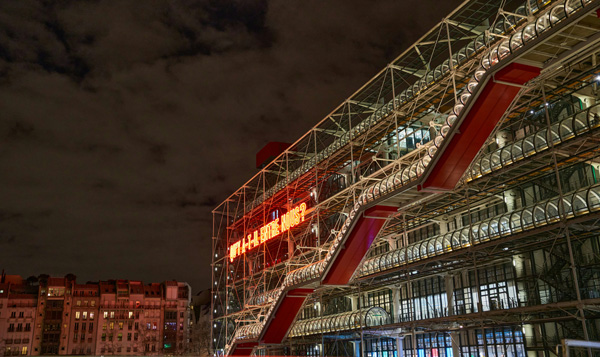“The Last Carnival” bids explosive farewell before the closing of Centre Pompidou

[Centre Pompidou at night. Photo credit: Unsplash]
A composition titled “The Last Carnival” was showcased on October 22, 2025, to celebrate the closing of Centre Pompidou.
Chinese artist Cai Guo-Qiang used fireworks and artificial intelligence to transform the museum’s exterior into a living work of art.
Curator Jérôme Neutres commented, “for the first time in its history, the Centre Pompidou’s façade becomes a monumental painting.”
He described the installation as “the artist’s most profound and complex work yet, in dialogue with both AI and the Parisian public.”
The event unfolded before a captivated crowd gathered in the plaza outside the museum.
A network of sensors and algorithms synchronized with Cai’s ignition system created shifting patterns of fire and smoke across the steel façade.
“The Last Carnival” lasted only minutes before dissipating into the air, leaving behind traces of pigment and ash.
Cai, born in Quanzhou in 1957, is renowned for his use of gunpowder as both material and metaphor.
His career encompasses painting, installation, performance, and large-scale explosions staged worldwide.
He has represented China at the Venice Biennale and produced firework events for the 2008 Beijing Olympics.
Cai’s art often explores the tension between creation and destruction.
In a 2019 interview, he said “Gunpowder has an inherent uncertainty and uncontrollability, and is an important means for me to relieve myself of constraint.”
His art has also faced controversy in past years.
A 2024 performance in Los Angeles triggered public alarm and minor injuries when debris fell into nearby streets.
His recent show in Tibet also drew criticism online for its environmental impact and cultural insensitivity.
The Centre Pompidou has long been a champion of experimental projects that bridge the gap between art and technology.
Since its inauguration in 1977, the center has been Europe’s first museum dedicated entirely to modern and contemporary art.
Designed by Renzo Piano and Richard Rogers, its exposed steel skeleton and color-coded pipes embodied a radical transparency that initially shocked Paris at the time.
Over the decades, it has hosted defining exhibitions, from Duchamp retrospectives to contemporary interventions, positioning it as a laboratory of artistic innovation and public participation.
Cai’s intervention continues that very legacy, reimagining the museum as both a canvas and a stage.
Public reception was divided.
Supporters lauded the work’s ambition and scale, describing it as a fusion of digital intelligence and elemental force.
Critics, however, raised concerns about the environmental impact of fireworks and the symbolism of combustion in an era of climate anxiety.
Neutres supported the project, viewing the work as “a metaphorical duel of control and chaos, destruction and rebirth.”
The performance also highlights a growing trend of AI being used as a creative partner rather than a tool.
Cai’s system, which responded to audience movement and urban data, blurred the boundaries between artist, machine, and environment.
Should technology-driven spectacle redefine what museums consider art, or does it risk turning cultural institutions into platforms for experimentation without accountability?
The event has raised important questions about the future of public art and institutional responsibility.
As the Pompidou prepares for renovation and temporary closure in 2026, ”The Last Carnival” stands as its final major commission before renewal.

- Minkyu Koo / Grade 11
- Chadwick International School

![THE HERALD STUDENT REPORTERS [US]](/assets/images/logo_student_us.png)
![THE HERALD STUDENT REPORTERS [Canada]](/assets/images/logo_student_ca.png)
